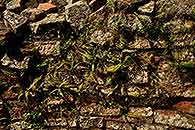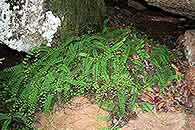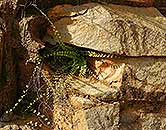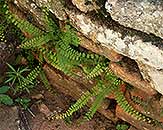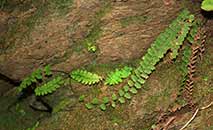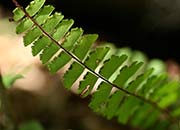Adiantum incisum Forssk.
Synonyms |
Adiantum caudatum sensu Sim |
|---|---|
Common name |
|
Description |
Rhizome short, erect, up to 10 mm in diameter; rhizome scales linear in outline, c. 4 mm in long and 0.2 mm wide, brown with pale margin. Fronds monomorphic, tufted, membranous to firmly herbaceous, arching. Stipe up to 8 cm long, dark brown to black, shiny, with numerous reddish brown hairs and long, linear, brown scales. Lamina pinnate, linear-lanceolate in outline, 10-40 × 2-4 cm, excluding a glabrous extension of the rhachis of varying length, which often ends in a proliferous bud or lamina with a terminal pinna; pinnae numerous (up to 40 pairs), persistent, shortly petiolate or sessile, alternate, subrectangular in outline, 7-23 × 4-11 mm, reduced in size towards the base and apex, the midrib forms the lower margin, outer margin irregularly incised into lobed, densely to sparsely hairy or sometimes almost without hairs, venation usually prominent; rhachis and pinnae thinly set with pale hairs. Sori on the undersurface of deflexed, membranous, oblong to lunate, glabrous or thinly hairy indusial flaps. |
Notes | A. incisum is pinnate and has a hairy rhachis. It resembles A. comorense which has a longer petiolule (2-4 mm) and pinnae that are not deeply incised. It also may be confused with Lindsaea odorata, an unrelated species, which has glabrous, non proliferous fronds, a creeping rhizome and smells of almonds when crushed. |
Derivation | incisum: cut-in; referring to the strongly incised pinna margins. |
Habitat | Terrestrial or lithophyte, on seasonally moist earthbanks, in rock crevices, at bolder bases in deciduous woodland or riverine forest. |
Distribution worldwide | Widespread in tropical Africa, also in S and SW Africa, Yemen (and India?). |
Distribution in Africa |
Angola, Benin, Botswana, Burundi, Ghana, Kenya, Malawi, Mozambique, Namibia, Nigeria, Rwanda, Somalia, South Africa, Sudan and South Sudan, Tanzania , Togo, Uganda, Zambia, Zimbabwe. |
Growth form |
Epiphytic, lithophytic, terrestrial. |
Literature |
|
